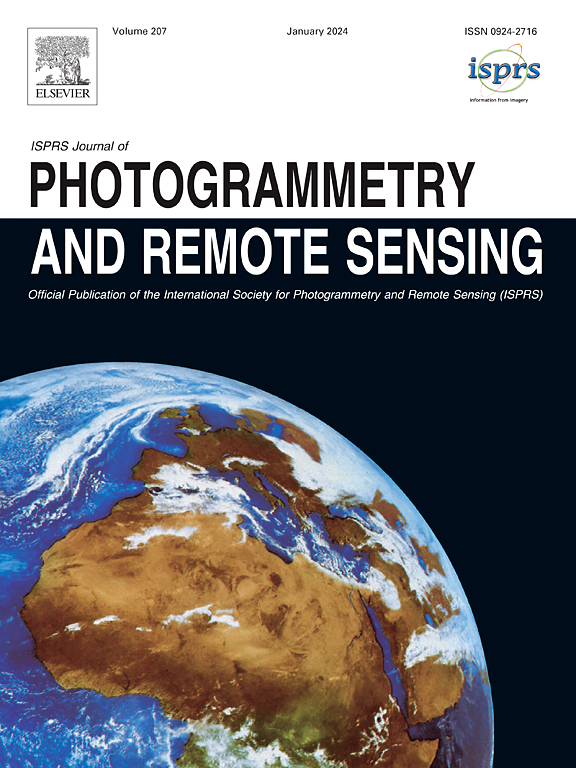BGSNet: A boundary-guided Siamese multitask network for semantic change detection from high-resolution remote sensing images
IF 12.2
1区 地球科学
Q1 GEOGRAPHY, PHYSICAL
ISPRS Journal of Photogrammetry and Remote Sensing
Pub Date : 2025-05-05
DOI:10.1016/j.isprsjprs.2025.04.030
引用次数: 0
Abstract
The accurate identification of land-surface changed classes when locating changed areas with regular boundaries from satellite images represents a significant challenge, particularly in these areas with considerable spectra and seasonal differences. This paper develops a boundary-guided Siamese multitask network, namely BGSNet, for the purpose of semantic change detection (SCD) from high-resolution remote sensing images. The objective of BGSNet is to utilize robust boundary semantics to enhance the intra-class consistency of change features, alleviating the pseudo-changes caused by temporal variances while retaining well boundary details. The proposed BGSNet consists of three tasks including bi-temporal semantic segmentation, changed areas detection, and boundary detection tasks. In particular, for the semantic segmentation task, a Siamese multilevel pyramid network based on transformer as feature extractors is introduced to fully capture robust semantic features of bi-temporal remote sensing images. For the boundary detection task, a multi-scale feature decoder is designed to enhance boundary semantic representation. For the change detection task, a boundary-contextual guided module is constructed to supply fine-grained semantic constraints, refining the boundaries of detected areas. Finally, we introduce a multitask self-adaptive weighting loss function that considers task uncertainty, which effectively balances the learning effects of different tasks, and improves the model’s adaptability to varied semantic change scenarios. Extensive experiments were conducted on the JiLin-1 and HRSCD datasets, demonstrating that BGSNet outperformed the eight state-of-the-art methods in identifying various semantic changes. Our methods produced the highest attribute accuracy, exceeding reference methods by 5.41%-29.63% and 2.94%-28.09% in SeK measures. Moreover, the detected results by BGSNet exhibited excellent boundary consistency with ground truth, resulting in the lowest geometric errors GTC of 0.187, 0.308, and 0.321 on the JiLin-1, HRSCD, and Fuzhou datasets, respectively. The proposed method also showed a high application promise in large-scale cropland non-agriculturalization scenarios with significant temporal and spectral variations. The code and data will be made available at https://github.com/long123524/BGSNet.
BGSNet:用于高分辨率遥感图像语义变化检测的边界引导Siamese多任务网络
在从卫星图像定位具有规则边界的变化地区时,准确识别地表变化类别是一项重大挑战,特别是在光谱和季节差异较大的地区。针对高分辨率遥感图像的语义变化检测,本文开发了一种边界引导的Siamese多任务网络,即BGSNet。BGSNet的目标是利用鲁棒边界语义增强类内变化特征的一致性,在保留良好边界细节的同时减轻时间方差引起的伪变化。提出的BGSNet包括双时态语义分割、变化区域检测和边界检测三个任务。特别是在语义分割任务中,引入了基于变压器的Siamese多层金字塔网络作为特征提取器,以充分捕获双时态遥感图像的鲁棒语义特征。对于边界检测任务,设计了一个多尺度特征解码器来增强边界语义表示。对于变更检测任务,构建了一个边界上下文引导模块来提供细粒度的语义约束,细化检测区域的边界。最后,我们引入了考虑任务不确定性的多任务自适应加权损失函数,有效地平衡了不同任务的学习效果,提高了模型对不同语义变化场景的适应性。在吉林一号和HRSCD数据集上进行的大量实验表明,BGSNet在识别各种语义变化方面优于8种最先进的方法。在SeK测量中,我们的方法获得了最高的属性准确度,分别比参考方法高出5.41% ~ 29.63%和2.94% ~ 28.09%。此外,BGSNet检测结果与地面真实值具有良好的边界一致性,在吉林-1、HRSCD和福州数据集上的几何误差GTC分别为0.187、0.308和0.321。该方法在时间和光谱变化较大的大规模农田非农业情景中也具有较高的应用前景。代码和数据将在https://github.com/long123524/BGSNet上提供。
本文章由计算机程序翻译,如有差异,请以英文原文为准。
求助全文
约1分钟内获得全文
求助全文
来源期刊

ISPRS Journal of Photogrammetry and Remote Sensing
工程技术-成像科学与照相技术
CiteScore
21.00
自引率
6.30%
发文量
273
审稿时长
40 days
期刊介绍:
The ISPRS Journal of Photogrammetry and Remote Sensing (P&RS) serves as the official journal of the International Society for Photogrammetry and Remote Sensing (ISPRS). It acts as a platform for scientists and professionals worldwide who are involved in various disciplines that utilize photogrammetry, remote sensing, spatial information systems, computer vision, and related fields. The journal aims to facilitate communication and dissemination of advancements in these disciplines, while also acting as a comprehensive source of reference and archive.
P&RS endeavors to publish high-quality, peer-reviewed research papers that are preferably original and have not been published before. These papers can cover scientific/research, technological development, or application/practical aspects. Additionally, the journal welcomes papers that are based on presentations from ISPRS meetings, as long as they are considered significant contributions to the aforementioned fields.
In particular, P&RS encourages the submission of papers that are of broad scientific interest, showcase innovative applications (especially in emerging fields), have an interdisciplinary focus, discuss topics that have received limited attention in P&RS or related journals, or explore new directions in scientific or professional realms. It is preferred that theoretical papers include practical applications, while papers focusing on systems and applications should include a theoretical background.
 求助内容:
求助内容: 应助结果提醒方式:
应助结果提醒方式:


